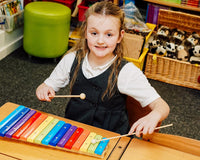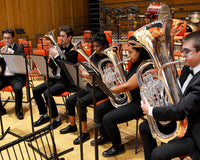There are many different musical terms used to indicated the dynamics, speed and character of a piece of music. A big part of these terms are in Latin, which makes it easier for musicians to communicate regardless of their native language. We have compiled the most popular music terms to guide you through the very basics of terminology.
A cappella – vocalist performing without accompaniment.
Accelerando – similar to the word ‘accelerate’, this term is used to describe gradual increase in the tempo.
Accents – notes played louder than normal to give it a distinctive beat. These are usually played to compliment other musicians or to make the current beat more expressive.
Allegro – indicates to play lively and fast.
Arpeggio – a broken chord, involves playing the notes of separately and consecutively, rather than all together.
Andante - indicating to play at medium, walking pace.
Atonal – music that has not been written with regard to any specific key or tonality.
Bar – this is a music technology term used to describe a unit that measures time decided by amount of beats in the time signature. For example if the bar 2/4 the bar would include 2 counts.
Beat – unit of musical rhythm.
Canon – is a type of composition that employs a melody followed by imitations of it played after some sort of duration.
Choir – a group of singers singing simultaneously aka chorus.
Chord – 3 or more notes played in harmony.
Click Track – similar to metronome, this is used to keep the correct time, especially useful for a drummer to develop a natural sense of time.
Common Time – the 4/4 time signature. This is commonly used in most genres of music, sometimes indicated in sheet music as ‘’C’’ which stands for common time.
Conductor – a director of a group of performers. The conductor indicates temp, dynamics and phrasing within a piece using a variety of gestures and facial expressions.
Concerto - a musical piece written for a solo instrument.
Crescendo – a gradual increase in volume and intensity in a piece of music.
Development – where the main melody proceeds on to a different one, commonly found in Sonata form.
Diminuendo – also known as decrescendo is a decrease in loudness or intensity within a piece of music usually 
Dissonance – an interval/chord that lacks in harmony and therefore sounds harsh and discordant. It can sometimes occur before resolving itself with a harmonious chord/interval.
Dynamics – expressing the loudness, softness and different levels of intensity of a music piece. Indicated through symbols in a piece of music specifying volume.
Flat – a symbol indicating the key is diminished by a half a tone (semitone).
Forte – a symbol indicating to play loud.
Glissando – sliding between notes, particularly popular on a piano, especially during improvisations.
Harmony – an ear-pleasing combination of at least two notes played simultaneously. This also refers to chord progressions.
Homophony – a piece of music written to be sung or played in unison.
Impromptu – mainly an improvisational, short piece of music.
Interval – the distance between two notes.
Key – scale of notes/tonality named after the key (1st) note.
Key signature – flats/sharps at the beginning of the piece indicating the tonality and key it is written in.
Legato – a musical articulation technique that indicates the notes are played or sung smoothly, evenly and connected. On a piano this can also be achieved by some help from the sustain pedal.
Libretto – a book of text with words of an opera.
Maestro – refers to a particularly outstanding musician.
Major – a tonality that has a positive, uplifting character.
March – a piece of music written in marching two-step time. Originally used for military events.
Measure – this is a music theory term referring to space of time decided by amount of beats in the time signature.
Metronome – a metronome is used to keep and develop a sense of time for musicians. A metronome can be set to any tempo and some can be set to also play smaller measures of the bar such as 8th notes, 16th notes etc.
Mezzo – stands for ‘inbetween’, for example mezzo soprano range is between soprano and alto or mezzo forte would be louder than piano but not quite as loud as forte and so on.
Minor – the opposite of major tonalities, minors have a more sombre and darker character.
Moderato - moderate.
Motif – leading or primary melody that is developed further in a piece of music.
Musicology – study of many forms, methods and history of music.
Natural – a symbol in sheet music that returns a note to its original pitch after it has been altered by flats or sharps.
Notation – developed in 8th century, refers to different methods of writing/scoring .music
Octave – begins and ends with a keynote and incorporates 8 full tones (Latin ‘octa’ = eight).
Opera – a musical drama where lines are sung rather than spoken.
Ostinato – repeated phrase.
Phrase – a musical sentence.
Piano – and indicator in sheet music to play softly, quietly.
Pitch – a frequency determining how high or low a note sounds.
Poco - a little.
Polyrhythm or Cross Rhythms – these refers to playing 2 contrasting rhythm patterns simultaneously, for example: 
Polyphony – a combination of different but harmonising melodies played at the same time.
Polytonality – two or more keys played simultaneously.
Portamento – a milder form of glissando.
Presto – indicating that the piece of music is to be played very fast.
Progression – a movement of chords/intervals.
Rallentando - gradually getting slower.
Recital – a piece of music written for a solo instrument without accompaniment.
Register – in other words, the range of an instrument or voice.
Relative major/minor – majors and minors that share the same notes within a scale. In majors, you will find a relative minor on the 6th note of the major scale and in minors you will find the relative major on the 3rd note of the minor scale.
Rhythm – element of music that keeps the time and supports other instruments using accented and unaccented beats.
Root – the key note of a triad/chord.
Scale – consecutive notes based on a tonality or mode either ascending or descending. There are many alternative variations and types to major and minor scales.
Sharp – a sharp indicates that a note is raised by a semi tone.
Slide – another word for glissando or portamento. Slide can also refer to the moving part of a trombone.
Slur – a curve over/underneath notes to indicate that they are to be played legato.
Sonata form – a complex piece of music that usually starts from exposition, followed by development and recapitulation.
Staccato – a form of musical articulation that involves playing notes sharply and detached or separated from others.
Symphony – a piece written for an orchestra, commonly in sonata form.
Tempo – indicates speed.
Theme – a leading melody or an idea in a piece of music.
Time Signature – a numeric at the start of the piece indicating a number of beats per bar.
Tone – the intonation, pitch and character of a piece of music expressing the feeling and attitude.
Treble – playing or singing in the upper range.
Triad – a combination of three notes consisting of root note (first), third and the fifth notes of the scale or mode.
Tuning – altering of the pitch in order to produce the correct tone.
Unison – two or more notes/voices being sung/played simultaneously.
Vibrato – common in singing, vibrato refers to slight variation in pitch to create a reverberating, fuller sound.
Vivace - lively.
Vocal range similar to instruments, human voice also has different registers or pitch. Female voices span from alto/contralto (lowest range) up to soprano (highest range) and some even have a whistle register. The lowest male voice is bass and the highest voice would be tenor, however, some male singers also sing falsetto. This limits vibration of the vocal notes and is usually limited in power, however, allows you to sing beyond your vocal range.















